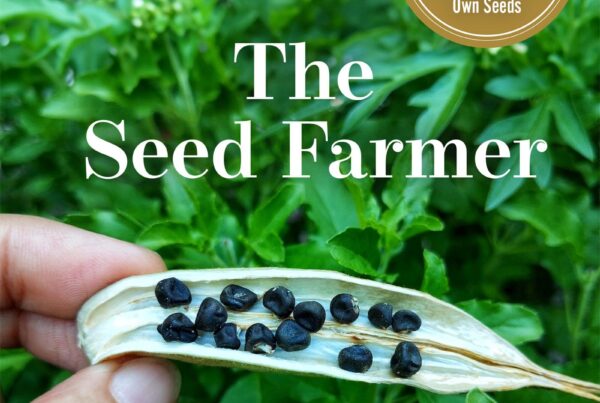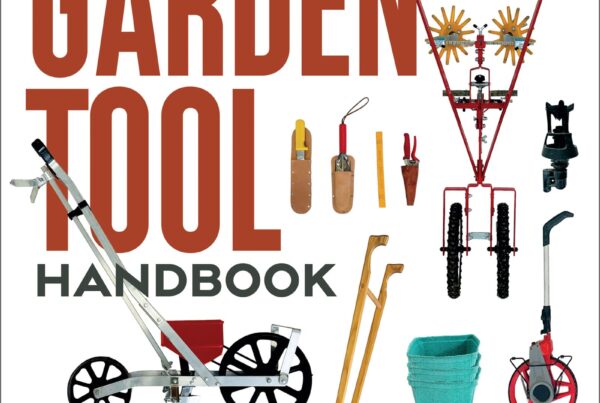This little book is not a how-to-farm book, but a very readable memoir-plus-life-philosophy of two activists who also raised a family and farmed organically, built their local community and served in founder and leadership roles in the Northeast Organic Farming Association. They favor minimized external energy use, natural healthcare and debt-free living. If you have some of the same goals, this book could be inspiration and encouragement. As well as the Many Hands Organic Farm CSA, their paid jobs on the board of NOFA and Jack’s job as a board game designer kept them afloat financially. Somehow they also found time to engage in music and theatrical arts and social justice work. They wrote their book in their separate voices, as interwoven sections. It’s usually easy to tell who is speaking.
The foreword is by Leah Penniman (co-founder of Soul Fire Farm and author of Farming While Black), who became a farm intern at Many Hands in her late teens, and was praised as “no question the best worker on the farm”.
Julie and Jack met in Boston in 1976. They shared values of trusting in nature, surrounding themselves with life, using their talents, respecting details, and staying skeptical but open. Each of the authors had many years of organizing and political activity under their belt before they met and moved in together in Boston, where they made a small garden, complete with compost bin and rabbit hutch. They ate well, sold 10,000 copies of one of Jack’s board games, saved money, had their first child, and after five years, planned to move to the country. They bought a 55-acre parcel of a 400-acre ex-dairy farm near Barre, Massachusetts.
They camped there, read, planned, and planted fruit trees, and had their next child. They needed to build a house, which would require saving for a year. They wanted to use the sun and earth for heating and cooling, wood for cooking and hot water, greenhouses and root cellars. They designed matching their dream, foregoing a furnace in favor of woodstoves; earth-berming the basement; running all their plumbing in a central column far from the external walls to avoid freezing; and building a basement root cellar with fan-assisted air circulation.
Their house has three floors plus an attic, providing maximum living space for minimal foundation structure. Despite such careful planning, they do see some flaws. If starting over, they would include barns and sheds attached to the house, under the same roof. When the electricity is out, the well-pump doesn’t work. They had not planned a secondary water source. Condensation of warm moist air on cold pipes and walls came as an unpleasant surprise.
Learning that half the total cost of a house was for labor, they decided to provide that themselves. Also learning that half the total cost (these can’t both be true, can they?) was for interior finishing (flooring, walls, insulation, cabinets, and trim) they decided to do that too. Wisely, they brought a mobile home to the site to live in until the house had electricity, hot water and a septic system. They organized construction weekends for their friends. They wrote a weekly newsletter to boost morale and keep the workforce up-to-date. Julie and Jack worked as hard as they could (Jack leading the construction, Julie leading the cooking and childcare, not so revolutionary, but efficient for the short term).
In December, after 5 months of amateur construction work with a bit of professional help, the shell was closed in and they moved into the house (having spent one-quarter of the total cost). By then they had four young children. Moving into a shell of a house turned out to be a good decision for them, partly because they could change plans as needs became apparent. For example, adding a window in the north wall so they could see from indoors just what was happening outside. It was to take them ten years to finish the interior work, and it was better to live with daily improvements than to wait a long time for the perfect home.
Jack learned computer programming, took contract roofing work and did odd jobs locally, to repay the emergency family loans for closing in the house. Julie, meanwhile, together with neighbors, started the Barre Farmers Market, where she sold her crops.
Julie had left college early to save the world, and married young. When she met Jack she knew she had to leave that marriage in order to start a family with Jack. This was morally difficult for her, even while emotionally imperative. Children came along quickly (four in five years), born at home. They were raised to do chores, go to bed when told, do their best at school, tell the truth, treat others with respect, and suffer the consequences of inappropriate behavior.
All the children went to public school, as much to learn socialization as to get an education. Conversations round the dinner table expanded the scope of their education, as did talking in Spanish, encyclopedia quizzes and maps as wall décor. The NOFA community provided models of farm family life, including expectations of children doing chores. This gave them a good work ethic, leading to chances of paid jobs on other farms as they grew older.
Other children and young teens were drawn to the household as frequent visitors or as temporary residents. Julie calls them “children of the heart” and was happy to offer them a sanctuary from which to navigate their first rough transitions in life.
On the farm, Julie and Jack built up their soil at every opportunity, gathering organic matter wherever they went. Initially they fed themselves from a quarter-acre. After a few years, they expanded to sell at the farmers’ market. Later, Julie started a CSA (Community Supported Agriculture system) with 25 members, growing on an acre and a half, with hired workers, and a work-share option of four hours per week for a full share. They bought a Troybilt rototiller and wore out a complete set of tines every year in their rocky soil. This method worked for 30 years, upgrading to a wider tiller that could be pulled behind the four-wheel tractor they had bought, and a bed shaper. Julie calls herself a tillaholic, enjoying the results while becoming aware of the longer term damage happening.
In 2014 she became convinced by an impassioned talk by Graeme Sait, to focus on maximizing carbon in the soil as part of addressing climate change. Avoiding the oxidation of soil that comes with fluffing it up with a rototiller helps sequester carbon and reduce erosion. Julie became a convert to no-till, despite opposition from some of the workforce, and sold the tiller. Using mulches and more perennial crops are key parts of this strategy. They bought lots of rock dusts and added them to their fields, following the teachings of agronomist William Albrecht. By-then-grown son Dan was a big part of making this change happen.
The operating principles at MHOF are:
- Cooperate with nature, focusing on building good soil, not on eliminating pests.
- Healthy soil microbes are the highest goal, and the foundation of a strong farm.
- A healthy plant is resistant to insects and disease. [Yes, healthy plants are those that are not diseased. That’s a tautology. It is agreed that a plant requires all three features of the disease triangle: a susceptible host, the presence of a disease-causing organism (the pathogen) and a favorable environment for the disease. But, is it your fault if your plant does not resist the disease? This statement seems to blame the victim for problems that occur.]
- Exceptional health leads to exceptional results, another example of a statement proving itself.
- Biodiversity is key, providing resilience and strengthening the farm as a whole.
- Help the land grow nutritious food, by attending to soil fertility: test soils and amend as needed.
- Mulch matters, adding organic matter, feeding the soil micro-organisms, keeping the nutrients cycling round.
- Healthy natural landscapes include both plants and animals, and farm landscapes also benefit from animals.
- Cover crops have many soil benefits and many uses.
- Green growth is essential for feeding the soil micro-organisms year-round, as well as adding to the carbon in the soil.
- Silage tarps are valuable to suppress vegetative growth. Yes, the plastic is not a sustainable material. But many growers have concluded that on balance silage tarps can do more good than harm. The time on the soil is short (March to May at MHOF) and the impact is less than tilling, or leaving the soil bare. The worm casts seen on the soil surface when the tarps are removed seem to prove no long-term harm.
About eight years after the kids had grown and left home, in 2007 MHOF started working with Almost Home, a program for former prisoners of the county jail, who had addiction problems. They raised money to pay these people. Two or three at a time stayed for some years, and became friends. Julie was happy when the physical work, fresh air and hearty healthy food brought about positive change in the lives of some of these struggling people. After eleven years of this challenging work, they decided to retire from the stressful work with the ex-prison men, some of whom relapsed into addiction, including two who died of overdoses.
MHOF also hired Clare Caldwell as Julie’s farming partner, and some more full and part-time staff. Clare brought breakfast sandwiches to the ex-con workers, and is got along with all kinds of people. She has been at MHOF since 2008, including birthing and raising three children in that time. She and Julie work together very well while competing in the nicest possible way to do the hardest work.
The farm has an implicit guide for farm managers:
- If you can’t say anything nice about someone present, don’t say anything at all. It’s OK to rag on those absent, with the understanding that “what’s said on the farm stays on the farm.”
- Never ask someone else to do something that you wouldn’t do yourself (within your physical limitations).
- Do exercises and affirmations before the crew arrives. Put a smile on your face. You’ll feel more alert, calmer and more open to what happens.
- Be sure each day is well organized in advance. Have a written task list posted for those who forget.
- Good morale follows from being occupied in something you enjoy or are good at. Know each person’s skills. Be ready to switch people around if your first estimate doesn’t work out.
- Change things up. An hour is long enough for most people on any one task. Have contingency plans for different kinds of weather.
- Give people as much authority as they want and can manage. Silently “interview’ workers for their next potential role on the farm.
- Organize yourself out of a job. Hand over and move on. Line up the next task. Jack and Julie are now shedding overall responsibility for major parts of the farm management.
- Hold a high standard for all your workers. Be clear about job descriptions and remuneration.
- Distinguish between long-term workers, working shareholders and volunteers, making expectations clear.
- Make it fun. Some like to sing, play word games or discuss thorny topics. Others do not.
- Celebrate birthdays and important events. A cake, some music, a mention in the newsletter.
- Eat together. Offer breakfast, have someone make lunch for the crew. Expect all to help with cleanup.
- Offer incessant honest praise and appreciation.
- Don’t be afraid to apologize and own your mistakes. This builds trust.
- Resolve conflict by immediately addressing it in a non-judgmental way. Make agreements about future interactions.
- Take all comers, at least once. Give everybody a fair chance. Half a day, or a day.
My reviewing came unraveled when I read that Julie and Jack did not support Covid distancing, masking or vaccinations. They believed their immunity levels (and existing intake of supplements) were strong enough to protect them from this newly emerged virus, as it does for flu. I’m happy for them that when they got Covid they both got mild cases. And may have avoided spreading it to people more vulnerable than them. Not everyone has been so lucky. Some of us have lost family members, or got Long Covid. My sympathies go out to the bereaved and those with chronic illness. I don’t get why anyone would choose to ignore the scientific evidence (once it started to emerge). Clearly the authors do believe much medical science and do take treatment for other conditions, and add preventative supplements to their fantastic diet. As they say, the politicization of the disease didn’t help us. Nor does demonizing people with different opinions, who may be living in a different situation.
After selling to a hotel chef, then a small health food store, then the Barre Insight Meditation Center every time they held a retreat, they finally had a lucky break as CSAs became more widespread and well-known.
In 1990, the federal government appropriated the word “Organic”, setting up a national inspection, certification and labeling organization. The individual statewide organic organizations joined in the National Organic Program. Soon Organic standards were allowing fudges to organic food production, such as outdoor “porches” for laying hens in densely packed poultry sheds.
Both Jack and Julie were working for NOFA, Jack on the financial and campaigning sides, Julie on coordinating the bulk organic supplies order and gathering volunteers. The NOFA Summer Conference included people from seven northeastern states, and had been run by the Vermont chapter. Sadly, it owed lots of money to two Vermont colleges, and some other chapters refused to share the debt. Julie and Jack saved the conference by finding a good location in Massachusetts, and persuading the MA chapter to host the event from 1987. They were able to get the conference back as a money-earning event and repay the Vermont loans.
They also revived publication of a NOFA newsletter, gearing up from one issue per year to six. Controversial issues were fearlessly aired (mosquito-eradication pesticides, sewage sludge as fertilizer, the industrialization of farming, big farm subsidies from taxes, the national expectation of cheap food, GMOs, and animal ID chips (dropped by the government after huge resistance from farmers).
The newsletter editors also ran seminars from 2008-2018, in conjunction with the Bionutrient Food Association, where Dan Kittredge worked. Interest in nutrient density of food lead into thinking about carbon sequestration, and no-till farming as a way to reduce carbon burn-up (carbon dioxide build-up).
Around 2015, Jack (in his mid-seventies) started to retire from NOFA/Mass involvement, and in 2020 Julie retired from her role as director. Their graceful exits were marred by a major disagreement with the NOFA Interstate Council at the end of 2020. Jack focused an issue of the newsletter, The Natural Farmer, on whether or not hydroponics should be allowed within Organics. Jack’s openness to airing dissent brought forth a blistering criticism from those who thought this idea unworthy of the newsletter.
For the conference, Julie proposed a debate about Covid vaccination and the New York state law closing religious exemptions. This idea was seen by many farmers as pointless and divisive. Instead, the topic went to an issue of The Natural Farmer, edited by Jack as his final issue. Some readers wanted to pull the issue, but it was too late. Is it censorship to exclude controversial topics, or is it avoidance of unhelpful conflict in order to focus on moving forward on agreed topics?
After 36 years working for NOFA, Julie (now 70) was happy to return to full-time farming, and continue educational work through a weekly farm newsletter and the Many Hands Sustainability Center, with weekly hosting of boys from a school providing for those recovering from sexual abuse; and seven workshops per year for members of the public. Jack is preparing to pass on their legacy, the farm, to a land trust. This means that their 55 acres cannot be further built on, and remains available to future buyers at a lower, non-development price.
Here are two people who were clear in their goals, applied themselves with gusto, achieved all their important aspirations, wrote it up, and roundly deserve to rest on their laurels.







